What is Programmatic Advertising? An Overview of Display Advertising
Mục Lục
Programmatic advertising is a very critical part of online marketing, which can be called the backbone of today’s online advertising methods like Google and Facebook. However, people’s understanding of programmatic advertising is still limited nowadays and many misconceptions are still remained. This article aims to privide you with an overview of programmatic advertising, its role in display advertising, and its role in the current and future advertising formats.
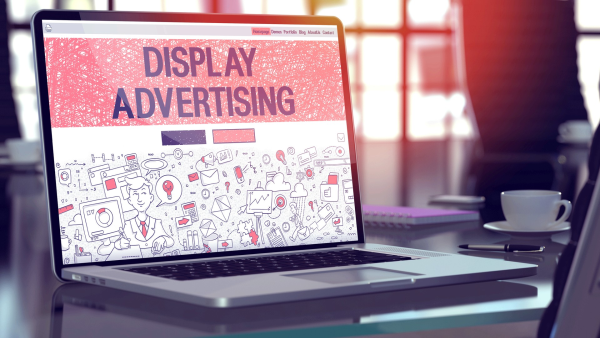
source: shutterstock
1. What is Display Advertising?
Before talking about definitions, it’s necessary that we understand the following terms:
Publisher: This is generally understood as the website or platform that allows the display of ads on it. This publisher term is expanding, including:
+ Websites: including news or entertainment websites vnexpress, dantri, 24h, …
+ Video platforms: Youtube, Vimeo, Phimmoi, …
+ Social Media: Facebook, Instagram, Pinterest, …
+ Desktop or mobile applications: Skype, Zalo, Youtube, …
Advertisers: Brands, companies, individuals, or organizations who spend money on advertising.
Agency: Companies that specialize in buying ads and conducting advertising campaigns for their clients (advertisers).
Inventory: The slot that the publishers have in which the ads are displayed. For example, the top banner position is a slot inventory, the right banner is another inventory slot.
Display ads: ads that are displayed, there are many different formats: text, image, video, flash.
Then what is display advertising?
Display advertising is an advertising method in which advertisers or agencies deliver their communication messages to potential customers through publishers using display ads.
You may also see banner ads on the website when you visit it, the video ads on Youtube clips before you watch or banner ads under the phone application while you are using. They are all parts of display advertising.
How display advertising and programmatic advertising are related? And how is the underlying mechanism of display advertising? What is programmatic buying? What is real time bidding? The sections below will answer these questions for you.
2. An Overview of the Display Advertising Ecosystem
At the beginning, the ads trading was very simple and manual: if an advertiser / agency wanted to buy some ads, they would just contact directly with the publishers. For example, you, an advertiser, contacted a sales person from a newspaper and asked to buy a banner on the top home page of the website for a week, it’s called Direct Buying (I will explain more below).

source: conversion.vn
However, things will get a little more complicated if you have an advertising campaign and want to run your ads on more publishers. And we are not mentioning the fact that each publisher has many categories internally, and in each section, it has many specialized pages and each page has many banners on it. In addition, advertisers sometimes only want to reach a specific part of the publisher’s users and visitors, not the whole. And we should not forget the story of when many advertisers want to buy a same inventory. Or what are the empty inventories supposed to be?

source: conversion.vn
Advertisers want to be able to buy ads in the most convenient way, with the best cost and efficiency. Publishers want to maximize their advertising inventories and earn the highest return for each ad unit sold. These two wishes can sometimes and somehow be conflicted with each other in terms of cost: one side wants to buy good and low-priced advertising while one wants to sell ads at the highest price possible.
Direct Buying in this situation is not a favorable solution because it will take too much human resource and cost to implement and track, and in addition it will not satisfy the desire of both parties as explained above.
Hence a critical need arises for a system that can:
– Help publishers manage their inventory efficiently: tracking which inventory is left, how much it can be sold with which price
– Benefit advertisers better: they can buy ads on many different publishers without having to work with multiple sellers at the same time
– Run an auction when multiple advertisers want to purchase the same inventory
– Help buyers select where their ad will appear based on a number of available targeting segments.
The Emergence of Ad Network
At this point ad network appears to somewhat address the needs above. We can understand ad network as a party that owns or cooperates with publishers and sells advertisements on these publishers using a technical basis, which may be already available like OpenX, Revive, DoubleClick or self-build.

source: conversion.vn
In Vietnam, there are some well-known ad networks including: Admicro, Eclick, Adtima, Lava, BlueSeed, Google Display Network (GDN), etc.
With the success of the GDN and some large local ad networks, a myriad of smaller ad networks have mushroomed after rain. The period between 2013 and 2014 in Vietnam was the time when you who worked in the industry could clearly see this massive expansion in Vietnam.
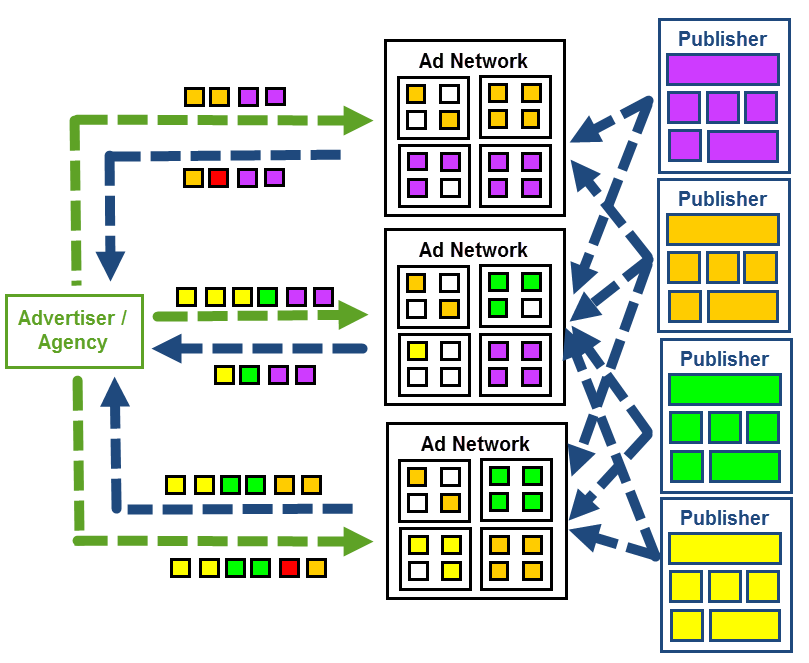
source: conversion.vn
The ad networks operate independently but at the same time there are some overlaps in the publishers they own. For example, a publisher can be a member of Ad Network A and at the same time of Network B and also participate in the Google Display Network. There are some publishers that exclusively belong to a certain ad network (for example, vnexpress can only be accessible on Eclick or dantri can only be accessible on Admicro) and therefore if users want to buy ads on that publisher, it is mandatory that they have to work with that ad network.
Some issues with the ad network:
– At this point, if advertisers wants to reach exclusive publishers, then they has to work with different ad networks. The inherent convenience at first is now lessened: instead of having to work with multiple publishers, you now have to deal with multiple ad networks.
– If a publisher is in multiple ad networks, it may be possible that an inventory is concurrently bought by the same advertiser via different ad networks. In some cases you will see on the same page, the same ad of a brand appears in 2 different positions. First of all, this is a waste of money, and then the advertisers are charged double for the same impression.
– Still this does not fully solve the problem of inventories for publishers.
– Targeting on ad networks is still limited by the number of publishers and ad networks.

Purchasing the same inventory, banner ads appear in two different inventory slot on the same page
Then it came the Ad Exchange
What is ad exchange? Ad Exchange acts as a marketplace where publishers and ad networks can connect to sell available inventories in form of real time bidding. Ad Exchange also collects the auction data to provide information for both buyers and sellers, and at the same time uses that data for better ad exchanging (targeting, pricing, inventory quality, etc.).
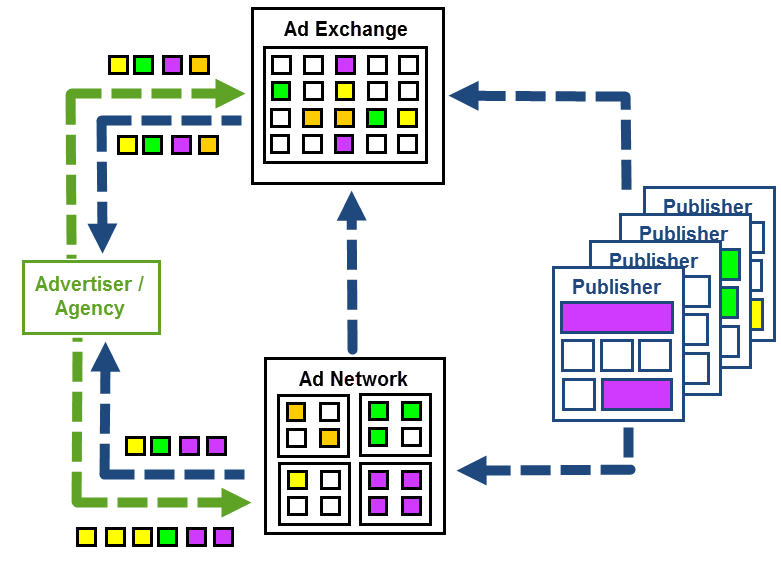
Source: conversion.vn
Ad Exchange helps us solve a number of issues:
– Help publishers lower inventory redundancy and maximize the selling price
– Help advertisers better target their customers with collecting data for data-driven ad, the ability to bid and control the price .
– It is also more convenient for advertisers as they can buy inventory from many different ad networks and publishers (those that sell the inventory to ad exchange)
However, Ad Exchange faces the problem of inventory quality as publishers and ad networks often view this as a place to sell surplus inventories. And the quality of these inventories are sometimes questionable (poorly positioned at the bottom, hard to find, or located in sub-pages) and this causes some headaches:
– Poor inventory quality will make the advertisers doubt the effectiveness of the platform and at the same time make them hesitate to bid high for these inventory.
– Publishers / ad networks find it hard to sell their inventory at the expected price and they do not want to bring in good inventory to this marketplace if they can sell themselves at higher prices.
DSP, SSP and ATD jumped in
Reaching here, you will find that the advertiser / agency is the buyer and the publisher is the seller of the ads. Each party has a very clear objective:
– Advertising buyers: how to buy advertising in the most convenient way, with the best cost and reaching the right audience
– Advertiser: how to sell ads with the best price, in the fastest way and the ads should match the content that the audience is watching.
Here we see an aspect that can cause conflicts of interest: one side wants to sell higher prices and one wants lower prices (let’s not talk about quality for now). From the beginning, all systems such as ad networks and ad exchange have eliminated traffic purchasing using human resources. However, there is a step where human participation is still needed: optimization. Whether it’s the optimization for more effective ads, lower costs, or optimizing inventory price and auctions to earn more revenue, human still play an important role.
At this point DSP, SSP appeared with the hope of replacing the work of human resources mentioned above. Then what is DSP? What is SSP? And how do these two components contribute to the display advertising ecosystem?
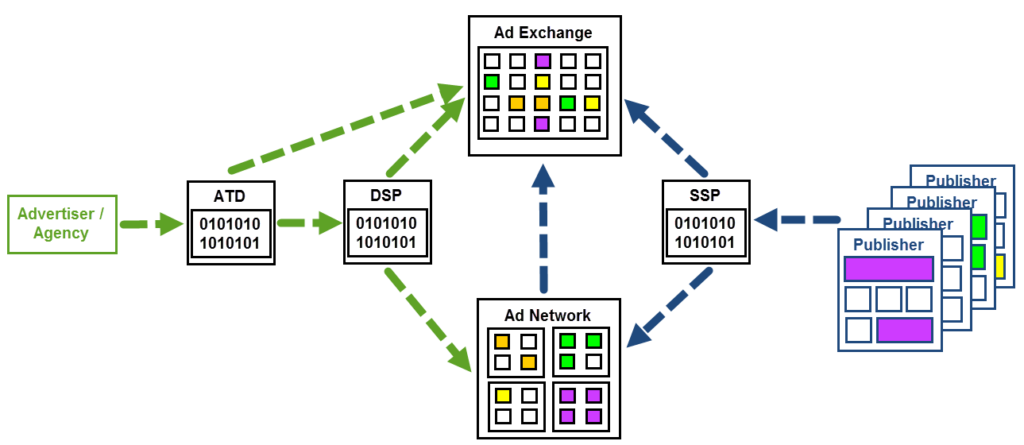
Source: conversion.vn
– DSP stands for Demand Side Platform and as it is named, DSP’s primary goal is to help advertisers / agencies make more effective advertising purchases (more effective cost, more accurate targeting) without the human help (ideally).
– SSP stands for Supply Side Platform (or Sell Side Platform) and acts as a symmetrical system of DSP, primarily serve publishers to help them achieve better sales of inventory (maximize profit and reduce inventory redundancy) and also without human intervention (again, ideally).
DSPs and SSPs can both join the Ad Exchange or Ad Network, and these tools rely on two things to start optimizing: buyer / seller settings and data acquired during running the ads. Using data and settings, the DSP / SSP algorithms automatically optimize and continually improve the efficiency of the buying and selling of ads and help both advertisers and publishers achieve their goals. The vision behind the DSP / SSP system is that ads buying and selling in the future should be fully automated and require no human involvement.
However, even though DSP and SSP have been on the market for years, they have not been able to completely replace human activity in the display ecosystem. Especially for DSP, in order to optimize advertising effectiveness, it is now dependent on many factors and the system needs a large amount of data for analysis before it can start working effectively. Many of today’s DSP systems still cannot function automatically without the interference of human and as such the advertisers’ trust on them is still very low. However, DSP / SSP and the automation of display advertising undoubtedly will be the trend of future and the whole ecosystem is still being in the transition. However, how long this transition will take depends on a number of other trends, such as Big Data and AI.
Then what is the ATD on the image above? ATD stands for Agency Trading Desk, which are systems built by a number of major / global agencies because they manage a lot of customer campaigns and spend a great deal of money every year in display advertising. ATD is built so that these agencies can collect data from the major campaigns they run, organize, arrange and analyze the data to collect insights. ATD can be linked directly to DSPs, Ad Exchange, or even Ad Network to improve ads purchasing, thanks to the data they already own. At this point, ATD can help DSP solve data problems and improve efficiency.
However, as mentioned above, only a few major agencies in the world own ATD and it is only used for some big customers with massive advertising budget, not applicable to the mass.
So you’ve been introduced to the components of display advertising ecosystem and their functions as well as their role in the whole system. At this time everything in the market is actually operating as diversely and flexibly as below:

Source: conversion.vn
Advertisers / agencies can buy ads with Ad Network, from DSP, with Ad Exchange (with or without ATD) or buy directly from publishers themselves. On the publisher’s side, they can sell ad inventory for Ad Network, Ad Exchange (with or without SSP), Ad Networks can also sell inventory for each other and Ad Networks can sell inventory to Ad Exchange. And all of that is the ecosystem of display advertising.
To make it easier for you to visualize this scenario, I’ll add some familiar brands to the ecosystem:
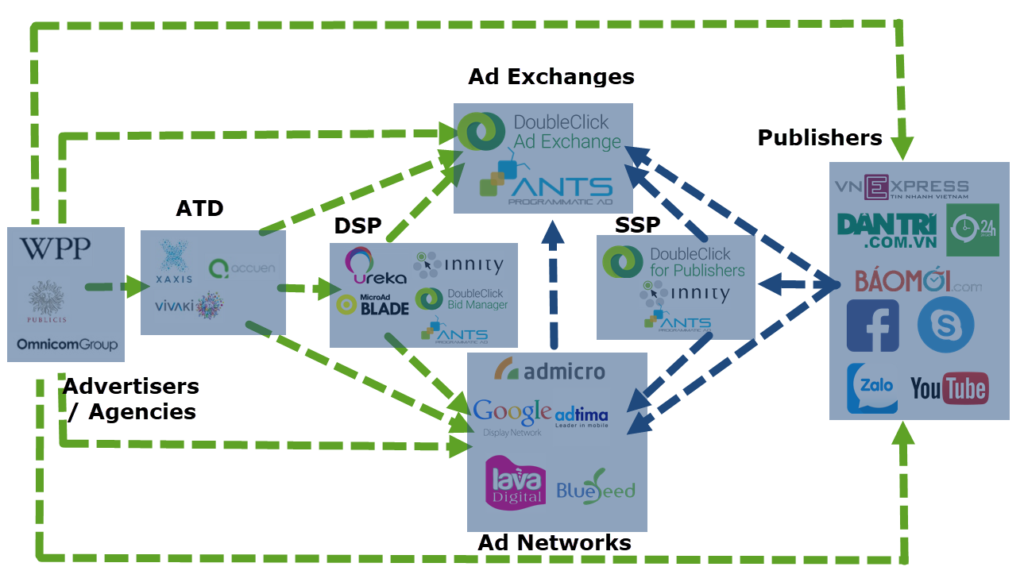
Source: conversion.vn
* The image above can only list some parties as an example, not a whole of Vietnamese display advertising
We will see that news site or social media sites like Facebook and Youtube, and apps such as Skype or Zalo can serve as publishers in the ecosystem. Advertisers are almost all companies and brands who need advertising, and I list several large agencies which own some of leading ATDs (they are only used for some key customers, however).
Moving to the ad networks, we see some familiar brands such as Google Display Network, Admicro, Adtima, Lava or BlueSeed. Each ad network specializes in one specific direction, some focus on websites, some concentrate on mobile applications, some target on video format or some only sell sites that they own.
Google currently owns both buyer and seller side systems that supports DSP (DoubleClick Bid Manager), SSP (DoubleClick for Publishers), and Ad Exchange (DoubleClick Ad Exchange). In Vietnam, we have ANTS who is now also moving in the same direction of building their own ecosystems. Some companies, like Innity, have DSPs, SSPs (they also have Ad Exchange but do not seem to launch it in Vietnam yet), some like MicroAd and Ureka focus on providing DSP solutions.
You can also see another article on display advertising ecosystems that are based around a brand.
You can watch this video, it sums up all of what I said above:
Well, hopefully you have a better understanding of the display ecosystem in term of platform as well as current market players and what’s the role of each side. Next time if someone asks you how Admicro and MicroAd are different (except for their name), hopefully you know how to respond. As we talk about things that are making confusion, let’s move on to the next section:
3. What is programmatic advertising and some misunderstandings?
The above parts help you know what Display Advertising is about, and I’ve talked about buying advertising among components. In this section I want to explain deeper about the trade. In summary, there are only two main types of display advertising:
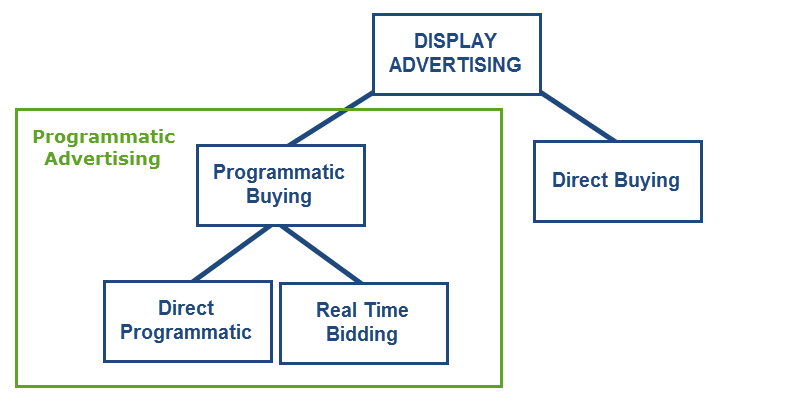
Source: conversion.vn
Direct buying: This is the usual form of buying and selling ads when you contact the publishers to book your banner ads in a certain location. In short, it is buying directly, and manually. However, with this format, you can make sure the position you buy will be guaranteed. For example, book the home page of an A website for a week and pay for it, it’s without doubt that they will display your banner next week.
Programmatic buying: This is a fully automated ad buying method that uses the system and completely eliminates human intervention in the trading of ads between parties. Ad Network, Ad Exchange, SSP, DSP are the systems that do this. At this point, if you buy an ad, you do not need to contact the parties, just log into the system and set up an ad buying command. Within programmatic buying, there are two different purchasing options:
+ Direct programmatic: Direct ad buy via automated system with guaranteed inventory at predefined price. It’s similar to direct buying but at the moment things are automated and human involvement does not exist anymore.
+ Real time bidding (RTB): Buying ads by auction method without a fixed price and inventory is not guaranteed.
Now we can divide the ecosystem into two parts, the buyer and the seller, with the Ad Exchange and the Ad Network in the middle to promote trading activities and with real time bidding as a regular used method.

Source: conversion.vn
The entire programmatic buying as well as its buying and selling methods are programmatic advertising and it is a part of display advertising. We need to clarify some myths that people usually misunderstand:
Programmatic advertising = display advertising: this is not true because programmatic advertising is only a part of display advertising, which also includes non-programmatic activities.
Programmatic advertising = real time bidding: this is not true because real time bidding is only a method of buying advertising in programmatic advertising.
Programmatic advertising = marketing automation: not true because these are completely different concepts. Programmatic advertising is about automation in display advertising trading and marketing automation is about automating processes, marketing activities, and interactions between brands and customers. We will have a detailed and decitated article on this topic later.
4. Everything is about the eCPM
Understanding publishers and how they make money
Before talking about the eCPM, I wanted to explain a little about the relationship between publishers and systems like Ad Network or Ad Exchange and how it works. To better understand this concept, we use Google Display Network which can be seen the world’s largest Ad Network system as an example:

Nguồn: conversion.vn
You likely have heard about Google Adsense, which Vietnamese online money makers like to say: play Adsense. And you know you can run ads on Google Display Network with Google Adwords. What is the relationship between these elements? For example, I have this website conversion.vn and because the website has positive monthly traffic, I want to earn more from it. I will sign up for the Google Adsense program and this party will provide me with a code to add to the website. On my website I only want to put a banner on the top of the home page because I do not want to have too many ads, which affects user experiences. At this point I just put this code on the website where I want the ad is to complete the setup process.
Once the conversion.com website is registered with Adsense, it becomes part of the Google Display Network system and it will be categorized on traffic and subject, content, keywords, etc. . If there is someone set up an advertising campaign on Google Adwords and choose Google Display Network to display their ads, and if the installation of their ads matches the topic, content and keywords of conversion.vn then their ads will be shown on the position where I have the advertising code attached. Every time someone loads my homepage, Google Display Network will count it as 1 impression, and every 1000 impressions is counted as CPM. The whole sale, whether with ad network, ad exchange or whatever, is always about CPM.
Now, if I want to maximize the profit I make from advertising, there is something I could do:
– Letting the banner ads displayed on all pages, not just homepage. So all the views on all pages will create an impression, not just a homepage.
– Each page will display 3 ad positions instead of just 1 as at first. For now, a view on each page will create 3 impressions, not just one as before.
– Increasing traffic to my website. Many traffic will generate more views and therefore create more impressions and bring me more money.
– Creating better content to drive the user back and thereby generating more natural traffic, making more revenue.

Source: internet
I can even use some “tricks” if I want to make even more money :
– Generating fake traffic (from bots, software, not real people) to my website, creating false impressions to fool the Adsense system. These fake traffic methods are becoming increasingly sophisticated by converting IPs, browser information, and devices or even using interactive techniques to trick Google’s test system (or other ad networks).
– Generating hidden traffics by automatically popping up tabs hidden on the user’s browser, generating impressions which seem to be from real users, though actually they are completely unaware of and of course these impressions create no value for advertisers.
– Infecting adware and malware on users’ computers in different ways and controlling their computer to automatically access the website’s pages to automatically generate hidden traffic that they totally don’t know.
– Using social networks to publishing disputed, controversia and fake news to attract traffic to my website and create more impressions.
etc.

Source: internet
Or even using these kind of content to attract poor quality traffic
These are just some of the methods and you can see that there are some ways you should follow and some you should not, but the money generated from traffic is so high that the parties are willing to go too far just to earn more revenue. But that is not good for themselves as well as for the whole market. You may not know, but Vietnam is the world leader in cheating Google Adsense with all kind of tricks. Those guys who can do that are so proud of themselves, of thinking that they have deep expertise (and can make a lot of money) and start teaching automated money-making courses, but they do not know that what they do lowered the value and quality of the whole Google Display Network system in Vietnam. According to a study from Google itself, 56% of display ads are unseen, and cheating is one of the biggest causes. Reducing the quality of the Google Display Network will cause advertisers to lose faith in this advertising channel, spend less, and lower CPM prices, and publishers will also be making less money, things will get more competitive. And the undeniable consequence of many years of cheating Google is that it has stopped registering new members of the Google Adsense system in Vietnam.
CPM is the common currency of the entire programmatic system
Many brands are still buying ads from agencies, ad networks, ad exchanges or DSPs, as well as from publishers themselves. A method of payment is usually used by two parties:
CPD (cost per duration): Calculated by the amount of money spent on advertising over a period of time (day, week, month), for example, booking banner on the homepage for $ 50 million / week. How many impressions it has, how many clicks are generated in the process is no concern.
CPM (cost per mille): also known as cost per thousand impressions. Each impression is one time the ad is displayed when the user loads the website and it will be charged for every 1000 impressions on the system. Please note that the phrase used here is displayed, but whether or not a user sees your ad is another matter because, for example, your ad was shown but on the bottom of the page while 90% of users only reach the top without ever scrolling down, which will also mean that your impression bring no value.
CPC (cost per click): Only charged when someone clicks on your ad, no matter how many impressions it has. Again, please note that the term used here is click. Many people think that click leads to a website session (which then can be measured in Google Analytics). However, it is often a conflict between the two parties because the click and session number are so different. See more about the difference between click and session.
CPA (cost per action): the action here can be registering an account, filling form, downloading an application or buying on the website. Depending on the complexity of this action, the cost of CPA will also vary and only charged when the action is taken, no matter how many impressions, how many clicks come from that ad.

Source: Google
Except for the CPD, we may see the difficulty rising from CPM -> CPC —> CPA for the ad running side.
Selling CPM is easy, you just run the ads and get the numbers from the system and then charge. The only relevant indicator is the number of impressions. As mentioned above, CPM is also the underneath exchange method of all programmatic advertising systems.
Selling CPC is more difficult because switching from impression to click will raise up another related indicator which is CTR – the percentage of how many people click after seeing the ad. CTR is dominated primarily by elements such as the visual and content of the ad, or where the ad appears. For example, if the banner ad is not engaging, not attractive, the CTR will be reduced (such as 0.1% averagely but now it’s only 0.05%) which can naturally be understood that with the same number of impressions, the number of clicks coming from the campaign is lower.
Selling a CPA is far more difficult than it sounds (thus there are not a lot of CPA agencies) comparing to selling CPC. As with converting clicks from impressions, the process of moving from click to action has the conversion rate (CR) indicator – the number of people who perform a desired action divided by the number of visitors to the website. The problem is that CR is governed by various factors such as: content, experience on the website, product quality, how it compared to other products in the market or sometimes reputation of the manufacturer. There are some factors that agencies can interfere such as the content or experiences on the website, but factors related to the product or branding are almost out of their reach. It also depends on the industry, there will be some which are very difficult to commit actions such as sales or registration. See more ways to optimize your CR of the sales landing page.
In conclusion, agencies can sell ads in form of CPC or CPA, but in the end it will be all about how they figure out optimizing each CPM to generate more clicks, more actions for customers and agency is taking all risks from this process. What to sell is then dependent on their confidence in the company’s ability to optimize the ads. So we can assume that everything until the end is about eCPM (effective Cost per Mille) – optimizing the effectiveness of the CPM to create higher values (clicks or actions).
The article ends here, hopefully it gives you a rather complete look on programmatic advertising and its role in display advertising as well as answers to some of the issues that people often misunderstand about this array. If you have any comments please feel free to contact me here.
Brandcamp also made a remake of the video that I have presented on this topic during the workshop of the UAN community recently. You can watch it for free here: http://www.brandcamp.asia/course/43-Programmatic-Advertising



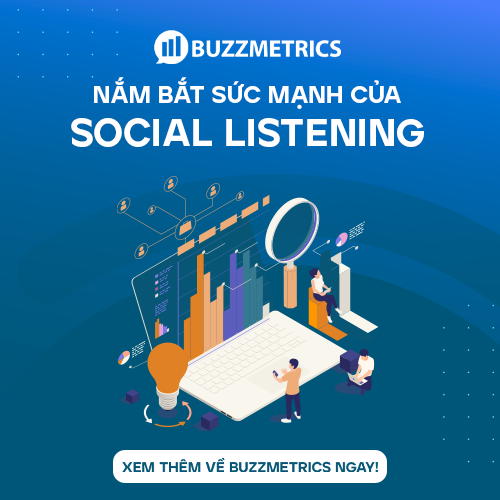
 Vietnamese
Vietnamese English
English